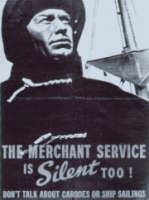|
|
|||||||
|
|
|||||||
 | |||||||
|
|
THE HISTORIC CONTRIBUTION OF CANADA'S MERCHANT NAVY
Canada's merchant navy was vital to the Allied cause during the Second World War. Its ships transported desperately needed equipment, fuel, goods and personnel to Europe and around the world. The very outcome of the war depended on the successful transport of troops and cargo by sea. Merchant seamen and women showed tremendous bravery on the ocean "battlefield". They faced fierce attacks by German submarines and hazardous, life-threatening weather conditions in the North Atlantic.
Going to War The Second World War began with Germany's invasion of Poland September 1, 1939. Britain and France declared war on September 3. Canada followed on September 10. Early information gathered by British intelligence agents about German ship movements led Canada to conscript all merchant ships two weeks before actually declaring war. On August 26, 1939 the Royal Canadian Navy took control of all shipping. When the war began, Canada had 38 ocean-going merchant vessels; by war's end, more than 400 cargo ships had been built in Canada. Many merchant sailors knew the dangers of shipping during war. They had experienced the dangers of mines and submarines during the First World War. Merchant crews were given training at special schools such as the Marine Engineering Instructional School in Prescott, Ontario and St. Margaret's Sea Training School in Hubbards, Nova Scotia. The Battle of the Atlantic
From the very beginning of the war, German submarines tried to cut supply routes across the Atlantic, threatening the transportation of vital goods and personnel to Britain. Along with the Royal Canadian Navy and Royal Canadian Air Force, the Canadian merchant navy played a key role in the six-year campaign to clear the Atlantic of U-boats. The Battle of the Atlantic was the only battle of the Second World War that was waged close to North American shores. German U-boats disrupted coastal shipping from the Caribbean to Halifax. During the summer of 1942, they even penetrated the Gulf of St. Lawrence. Early in the war, many merchant ships were lost because the aircraft escorting them reached the limits of their flight capacity and had to turn back before the ships reached their destinations. The navy solved the problem by building flight decks on merchant ships, and even creating Merchant Aircraft Carriers (MACS) - tankers or grain carriers equipped with a deck and three or four aircraft.
Merchant seamen bore much of the brunt of the Battle of the Atlantic. More than 1,600 Canadian merchant mariners died, including eight women. At the end of the war, Rear Admiral Leonard Murray, Commander-in-Chief, Canadian North Atlantic, said "the Battle of the Atlantic was not won by any Navy or Air Force, it was won by the courage, fortitude and determination of the British and Allied Merchant Navy." Merchant mariners would serve once more in wartime, during the Korean War, 1950-1953. Twelve Canadian flag ships helped deliver supplies. There were no casualties. For more detailed information on the heroic exploits of the "fourth arm" of Canada's fighting forces, refer to the VAC publication Valour At Sea. |
||||||
|
|
|||||||


